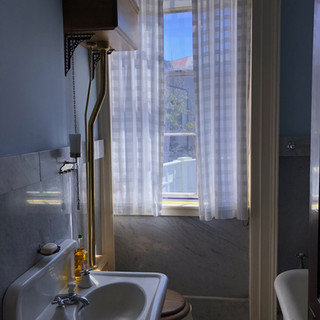
I became a Girl Scout when I was seven years old and in the second grade. I knew the minute I saw the Girl Scout flyer, at my school, that I wanted to be a Girl Scout. They went camping, which was something I wanted to experience. Then I found out you couldn’t go camping until you were in the fourth grade, but I didn’t even care. There were so many things to learn and do in Girl Scouts; I was hooked. Almost forty years later, I have been an active Girl Scout for 21 of those, and I finally made it to Juliet Gordon Low’s Birth Home.
Juliet Gordon Low was the woman who created Girl Scouts in the United States and also helped create the Girl Guides in England. She was born on Halloween in 1860 and was raised in Savannah, Georgia. The house in Savannah, Georgia, that honors her name, is where she was born and is a mecca for the Girl Scout Community. The house has been in the care of the Girl Scout Organization since 1953. It was originally built in 1821 and was occupied by the Gordon family from 1831 until 1953. The original owner was James Moore Wayne and he sold it to his niece, Sarah Stiles Gordon and her husband William Gordon. These were Juliet Gordon Low’s grandparents and her grandfather was the founder of the Central Georgia Railway.
The Gordon family had deep ties in DC and Juliet’s great-great uncle, who was the original owner of the house, was an associate judge of the US Supreme Court during the Civil War. His contacts in Washington DC helped keep the family safe and their home safe during the Civil War. Most of the furnishings and artwork were saved and still can be seen in the house.
The Federal-style Regency mansion, that is built of brick and covered with stucco, is a beautiful towering corner house. This is a house built for a prominent family that entertained countless guests over its years, including President Taft. As you approach the house, you notice that it consists of two floors of large windows, a third floor with smaller servants’ quarters windows and a windowed basement. It is a light beige color accented by sienna shutters and decorative grey fascia. It reminds you of homes that line the streets of Virginia and Maryland from the same period. The main entrance of the house has an elaborative roman pillared square awning with a staircase, parallel to the sidewalk, on each side of the doorway.
The current entrance to join a tour is a door right below the main entrance door between the two staircases. You are stepping down into the basement of the house. There is a small official desk to the right with a staff member waiting to help you. We visited the mansion during our spring break, which runs the second week in March. Since the entire country, except Texas, is in school, we walked up at 11:30am and were able to purchase tickets for the 11:45am tour. I don’t recommend this for traditional spring break times or the summer break. You can purchase tickets online as long as you do so at least two days in advance. I did try to purchase tickets the day before and was unable to do so online.
There is a bookstore to the left and the waiting area for the tour to the right. The bookstore has some fun Girl Scout patches, which you have to purchase if you are a Girl Scout. They also have a pin that you can wear on the front of your sash or vest, if you are a Girl Scout, that represents that you have taken a tour of the house. There is also a pin if you just visited the house. You can also wear these pins if you are an adult in Girl Scouts. Yes, I will be wearing mine. The waiting area for the tour on the right has a couple of rows of chairs that face a table and there is a fireplace on the opposite wall of where you enter.
Our tour guide came in and did a brief introduction of the house and of Juliet Gordon Low’s life. Then she took us outside and up the stairs to the main entrance of the house. The entrance way has Juliet Gordon Low’s Girl Scout hat and satchel. It also has a portrait of Juliet Gordon Low from 1919 and her posthumously presented Presidential Medal of Freedom. It was presented to the Girl Scouts in 2012.
Next you enter the main living room that is painted in a soft aqua color and contains numerous lounges and chairs. There are also no ropes stopping you from sitting on the furniture, but that would break the one rule for the house tour. Do not touch the furniture. There are many breakables in the house and some ephemeral things you can touch. There were three small kids on the tour and they headed straight for the couch to have a seat. Their mother immediately went over and got them up. My kids, at that age, would have done the same thing. Who I am kidding, my oldest had every intention of sitting down and I had to hold her hand. Make sure if you have a kid with cognitive disabilities to hold their hand during the tour. We had a few moments that we caught before they went awry. There are no ropes up and even though there is a rule of no touching, there is a lot to tempt you to touch. My autism kid fell victim to that a few times.
Also, in the room there are many portraits representing many of Juliet Gordon Low’s family. One of the portraits, a painting of her mother, was painted by Juliet Gordon Low. There is also a bust of her father that was sculpted by Juliet Gordon Low. The artwork continues into the next room with a beautiful landscape painting of Niagara Falls. It was painted long before the commercialization of the area and hangs above the fireplace. The light that bounces off the falls is breathtaking. It is dark and romantic. There are also a couple of additional works of art by Juliet Gordon Low. Try and see if you can find them before the tour guide points them out. The chandelier that hangs in this room was purchased at an auction. It is magnificent, and few rooms could hold the chandelier. The previous room had a duplicate chandelier that was created by Tiffany in New York at the request of Juliet Gordon Low’s father.
Across the hall you enter the formal dining room and above the banquet is a portrait of Juliet Gordon Low from the 1880s. This would be from around the time she was married. This is a duplicate of the painting that hangs in the Smithsonian in Washington DC. We were fortunate to see that painting during the Centennial Jamboree that celebrated the one hundredth year of Girl Scouts. In the side cabinet, with the glass doors, is a collection of beautifully decorated plates, with birds from the region, that were hand-painted by Juliet Gordon Low. As you exit the room and start to head up the staircase, don’t’ forget to take notice of the telephone on the wall to your right. You can ask you kids if they know what it is.
The staircase is lite by a beautiful circular patterned stain glass window. It fills the staircase with light and floods the second story hallway. The stairs are steeper than we are accustom to, so watch your pacing. On the second floor, you will see the bedrooms of Juliet Gordon Low and her family members. At this point, the tour guide let us walk around and view the rooms by ourselves and ask questions. Our tour guide was very patient with our child that likes to ask a lot of questions and make a lot of comments. In the first bedroom on the left, there is a table where you can write your wish and then in the next bedroom, Juliet Gordon Low’s bedroom, you can place it in the wish box. They had installed running water and a full working bathroom between the two bedrooms. There was a cute little sewing or sitting room at the front of the house and two additional bedrooms. There is no tour of the third floor because it has been turned into a working office area for Girl Scouts.
After we were done viewing all the rooms upstairs, we headed back downstairs to view the last room. The last room was a library, that had been renovated to be kid friendly and everything is touchable. There are numerous glass cabinets with rows and rows of books. There is a table in the middle with games and fun activities for kids from the different decades. There are iPads in the corners with woman giving speeches about finding your voice. They encourage kids to write a poem and place it in a box in the left front corner, beneath the poetry tree.
We exit outside through the side porch and this isn’t any simple porch. This is a magnificent porch that replicates the roman pillared style of the front porch but is about five times the size. It was refurbished right before Juliet Gordon Low’s wedding. She was the last of the Gordon children to get married. The porch overlooks the beautiful garden where Juliet Gordon Low spent a lot of her time. There is a bronze sculpture of her sitting on a bench to the right of the porch. They give you plenty of time to look around and enjoy the hidden secrets of the garden and all the special little touches that lie within.
As you head through the garden and around to the back of the house, there is a door in the center, of the back of the house, that takes you back into the basement. From there you can exit the basement through the door you entered at the front of the house. I highly recommend picking up a few items in the gift shop to remember your time in Savannah. If you are a Girl Scout, don’t forget to purchase a pin to wear on your sash or vest.
If you want to experience another part of Juliet Gordon Low’s life and learn more about the history of Girl Scouting, head to the First Headquarters. The First Headquarters is located behind the Andrew Low House in the what was the formerly the carriage house for the main house. It was willed to the Girl Scouts upon Juliette Gordon Low’s death in 1927.
If you need help deciding if this is for you, feel free to contact us about your sensory or cognitive disabilities. We would love to help you with your questions. comments@twoweeksayear.com
Juliet Gordon Low's Birthplace 10 E. Oglethorpe Avenue, Savannah, GA 31401 912 233-4501














































Comentarios